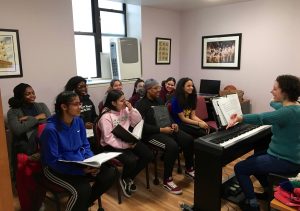HBV is not a warehouse for children. It does not exist to simply keep kids off the street and out of trouble. This is a program providing a rigorous music and academic education, and it proves its commitment to these children by teaching cumulative skills (Appendix B) centered around a Culturally Responsive Pedagogy and tone (Appendix C) that encourages multiple types of intelligence (Appendix D). Earlier, I mentioned that security cameras were checked before I was allowed through the door. In fact, there’s an intricate system of security cameras that keeps watch over the three doors, as well as the back gate and alleyway. The feed from these cameras appears on a monitor in the main reception area, as well as on Mary’s desk. I also mentioned the sign-in policy, and fact that visitors need to wear name tags.
When originally presenting this community in class, I described the space of HBV as being colorful and full of life, which was a semi-incorrect description. The space is neat and tidy, but rather stark and clutter-free by design. It was only after realizing that the children bring the color and the energy to HBV that I made a similar conclusion about the safety at HBV. While the sign-in sheets, name-tags, security cameras, doorbell, and locked doors provide security, I don’t think that’s where the kids’ sense of safety actually comes from. Instead, their sense of security comes from the structure, organization, and team of staff that support them. HBV is an environment where kids are allowed to safely explore a small corner of the world. Their security comes from a sense of belonging in that corner.
As I mention the stark space, I hesitate to call it bare or empty, because the minimalist design leaves space for taking out games, keyboards, movies, books, guitars, sports equipment, desks, or drums. The kids know where things belong, and therefore where they’ll be when looking for them. This sense of knowing, the confidence that comes when everything is in its place, offers a certain peace. I was particularly interested in the area in Rehearsal Hall 1 that is the designated binder shelf. From what I could see, the area was self-policed when it came to tidiness, and I couldn’t help but notice that the area tended to look exactly the same at the end of the evening as it did at the beginning of the afternoon. Knowing that every student passing through the doors of HBV also passes through this tiny area makes this tidiness even more impressive. This area is also the hub for information. Notices are posted here, as well as attendance status. On one particular afternoon, a girl asked the conductor how she was doing on her attendance, since she had been sick and missed a few days the week before. The conductor explained to the girl where the attendance information was posted, how to read the chart, and how to understand the result. The girl took the opportunity to take responsibility and find the information. (She was still above the required 70%.)
Knowing that every student passing through the doors of HBV also passes through this tiny area makes this tidiness even more impressive. This area is also the hub for information. Notices are posted here, as well as attendance status. On one particular afternoon, a girl asked the conductor how she was doing on her attendance, since she had been sick and missed a few days the week before. The conductor explained to the girl where the attendance information was posted, how to read the chart, and how to understand the result. The girl took the opportunity to take responsibility and find the information. (She was still above the required 70%.)
Maintaining an organized space offers opportunities to learn responsibility. These responsibilities build leadership skills, and teach students that they are capable of being in charge. For example, each choir has different student officers that in addition to checking the binder area at the end of rehearsal, manage things like passing out new music, making sure pencils are available, managing uniforms, and collecting permission slips. Based on the low economic status of the Bronx, according to Jean Anyon’s idea of the “hidden curriculum” based on social class, a program like HBV is run more like a program for the “executive elite” than the “working class.” In addition to having students understand their security systems, HBV invites students to implement and help adjust these systems to make them as efficient as possible. This encouragement and participation teaches these kids that structures and systems are malleable and negotiable: an understanding that helps them develop the abilities necessary to become leaders, designers, and owners of their futures (Anyon, 1980).
Leaders are willing to be wrong, and I witnessed countless examples of the kids being encouraged to try. Any time the kids were invited to take a chance, the comment made by the teachers was along the lines of: “Why not try? The worst that can happen is you’ll be wrong.” This tone of compassion and understanding is grounded in belief and confidence in the students. On one occasion, I observed a sectional rehearsal for the girls in Singers. They had been invited to perform for their State Representative as a part of Women’s History Month, and I watched the girls shift from trepidation to confidence as Mary excitedly explained that they would do a great job. I took a photo of the rehearsal at that moment, and if reading the girls’ expressions correctly, I can see them thinking, “Well, if Ms. Clementi thinks we can…” Mary then proceeded to offer musical options, having the girls decide collectively what they wanted to sing for the occasion.
